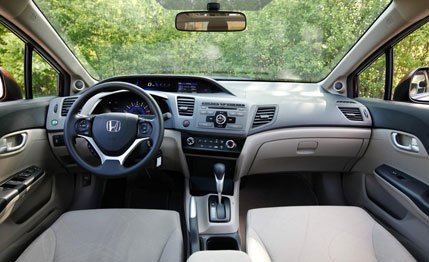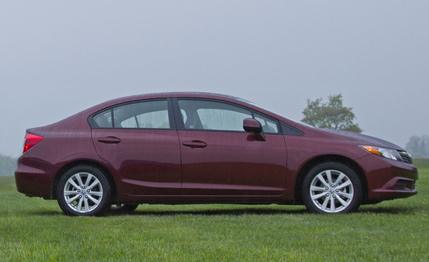
 Short Take Road Test
Short Take Road Test


It’s been a compact-car sales leader for decades, a pace setter in technical innovation since the clever emissions-reducing CVCC (“compound vortex controlled combustion”) engine in 1975, and a car whose fun-to-drive index has almost always ranked at the top of its class. Now here we are with the latest renewal—generation nine—and we confront the inevitable questions: Does the latest Honda Civic carry on the enviable tradition of its honorable ancestors? Is it still transportation for the spirit as well as the body?
Exterior design leader Toshiyuki Okumoto tells us that fun-to-drive is part of the persona. But he says he draws his dynamic inspiration—“energy coming from inside to outside”—through yoga, which may be spiritual but ain’t exactly kinetic.
The Car
An EX sedan with an automatic transmission—the variation tested here—isn’t exactly the most exciting Civic. Invited to help ourselves from the 2012 inventory, we’d go with the sportier and much more powerful Civic Si. But the EX trim level at the upper end of the Civic range gets a lot of the sales action—it’s what they call the “volume car” in the cubicles of marketing departments.
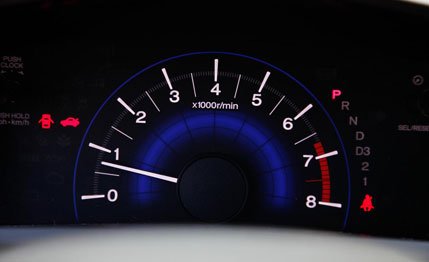

Consistent with previous policy, Honda’s trim levels tend to be complete packages; there are essentially no stand-alone options. The base DX sedan starts at $16,555. For $18,605, the LX trim adds cruise, an upgraded stereo with steering-wheel-mounted controls and a USB input, power windows and locks, and air conditioning. The EX sedan tested here is $21,255 and has a substantial list of standard features: power sunroof, Bluetooth connectivity, tilting-and-telescoping steering column, 16-inch aluminum wheels, and four-wheel disc brakes, to hit the highlights. If you want navigation and satellite radio, add $1500.
All-New?
Like car companies do with every redesign that comes along, Honda calls the latest Civic not merely new, but all-new. Even though the ninth-generation car’s footprint is unchanged from that of gen eight, that statement holds more truth here than in most applications. The wheelbase has shrunk by 1.2 inches to 105.1. (The coupe’s wheelbase diminishes by 1.1 inches to 103.2 inches.) Alterations to the wheelbase entail fundamental changes to a vehicle’s basic architecture—vindication for the “all-new” descriptor.
In the same vein, there’s more room within this similarly sized package. Honda claims an interior-volume increase of almost four cubic feet—now up to 95 cubes—versus the gen-eight sedan. The most readily apparent element of this gain is 1.6 inches of additional rear-seat legroom. Shoulder room has been increased—by three inches in the front and one in the back, according to Honda—interior plastics have lost their hard sheen, and skinnier A-pillars improve forward sightlines.
Déjà Vu?
All the foregoing is tangible, and welcome. Where the all-newness is hard to perceive, though, is from outside the car. Honda redid the Civic’s sheetmetal—it now has a longer hood and revised headlights, as well as other subtle creases and timid sculpting—but unless you see new and old parked cheek by jowl, we bet you’ll be hard pressed to see this car as new.
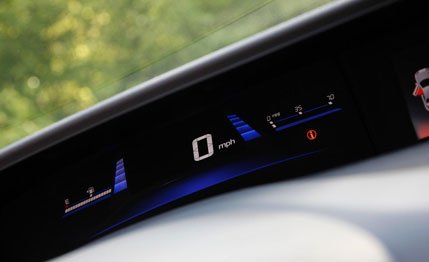

The previous generation was a bold break with the past and a design that stood out from the herd when it was introduced in 2005. It was refreshingly rare for Honda, but with this new generation, the design department has reverted to form: no risks, no distinction. Still swoopy enough to look interesting—Honda calls it “one motion design”—but not enough to provoke envious glances.
One positive note—although it doesn’t mitigate the cautious styling—is that the redesigned Civic weighs a little less than its predecessor. Depending on model and equipment, it is anywhere from 20 to 55 pounds lighter, according to Honda. That’s not much, but it’s rare for a new car today.
Déjà Vu All Over Again?
Another familiar element of the new Civic line lies under its sloping hood: the 1.8-liter SOHC 16-valve i-VTEC four, bolted to a five-speed automatic transmission. If you want a manual transmission—a five-speed—you have to go for one of the lesser trim levels (the EX was available with a manual last year). Your punishment for making this choice is that you can’t opt for Honda’s nav system, which is limited to the EX and EX-L trim levels. This means you can’t have satellite radio, either—it’s baked into the nav package.
But we digress. Honda made some friction-reducing refinements to the Civic’s mainstream four (there’s also the hybrid’s 1.5-liter version, paired with an electric motor). Output is unchanged—140 hp at 6500 rpm, 128 lb-ft at 4300—although the hp peak now arrives 200 rpm later. Considering its long-stroke design (81.0-mm bore, 87.3-mm stroke), the 6500-rpm power peak is pretty high. But it’s unlikely that owners will get there often, since the transmission wants to upshift as early as possible and doesn’t really invite manual operation.
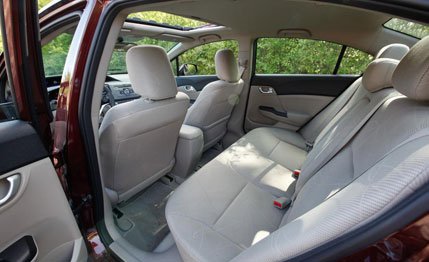

All the foregoing is about fuel economy, of course, and that’s the good news. Honda dodged the expense of adding direct fuel injection to the 1.8 but still cites EPA ratings of 28 mpg city/39 highway for the 2012 Civic EX, gains of 3 mpg in both categories. We averaged 33 mpg. It’s also interesting to note that EPA highway ratings are 3 mpg higher for the EX than for DX or LX editions equipped with the manual gearbox. The other good news is that ambient noise levels in the new EX are distinctly lower than in the gen-eight model.
The bad news? That would depend on your expectations. The 2012 Civic EX achieves 60 mph in nine seconds flat and drones through the quarter in 17 seconds at 83 mph. If you’re looking for haste, buddy, you’re shopping at the wrong store.
But Does She Dance?
The other top priority in the Civic redesign was refinement—quiet operation, creamy ride quality, cushy comfort. We must admit that Honda accomplished these objectives, but at what cost? The company slowed the ratio of the electric power steering, allegedly to enhance linearity. What we observe is diminished road feel and reduced response. The suspension tuning is noticeably softer, diluting transient response and allowing more-pronounced body motions.
Braking, rarely a strong suit with Civics, is merely adequate—184 feet from 70 to 0 mph. Adequate also applies to grip—0.82 g on the skidpad, delivered here by a set of Continental ContiProContact all-season tires measuring 205/55-16.
On the other side of the ledger, the new Civic sedan isolates its driver and occupants from the outside world in a way its predecessors did not. Assembly and materials are high quality, and for the driver whose requirements are limited to competence and comfort, the 2012 Civic will do very nicely. But another cog in the transmission would make the going even smoother, allowing the engine to spend more time in the comfortable part of its power band. We’re disappointed that the Civic is sticking with a five-speed auto while others (e.g., Hyundai Elantra, Ford Focus) are graduating to six-speeds.
More important, the eager responses that have characterized Civics over almost four decades are missing. For those drivers who seek involvement, the latest Civic will be disappointing. With the exception of the Si, Honda has turned the Civic’s character dial toward bland—turned it almost all the way to the stop.
